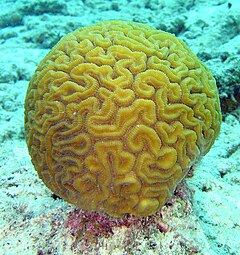User:Spaully/WIP Coral
Phylogeny
[edit]Anthozoa
[edit]new
[edit]| Anthozoa | ||||||||||||||||||||||||||||||||||||
| ||||||||||||||||||||||||||||||||||||
| Phylogeny of Anthozoa[1] |
| Anthozoa |
| Phylogeny of Anthozoa[1] |
- Subclass Octocorallia (8-way symmetry)
- Alcyonacea (soft corals and gorgonians)
- -Alcyoniina (polyp colonies connected by fleshy coenenchyme)
- -Protoalcyonaria (solitary polyps)
- -Scleraxona (colonial polyps connected by calcite)
- -Stolonifera (polyp colonies connected in ribbons or membranes)
- Helioporacea (colonies with hard aragonite skeletons; blue corals)
- Pennatulacea (sea pens)
- Subclass Hexacorallia (6-way symmetry (Zoantharia)
- Ceriantharia (solitary tube-shaped polyps; tube-dwelling anemonies)
- most basal class, rest is clade
- Actiniaria (tentacular soft-bodied solitary polyps; sea anemones)
- Antipatharia (colonial but non-calcareous with a skeleton of corallum)
- Corallimorpharia (soft-bodied solitary polyps with a different internal structure to Actiniaria)
- Scleractinia (colonial polyps with an external calcareous skeleton; the stony corals)
- Zoanthidea (soft-bodied polyps with two rows of tentacles)
- Ceriantharia (solitary tube-shaped polyps; tube-dwelling anemonies)
old
[edit]- Subclass Alcyonaria (= Octocorallia) (8-way symmetry)
- Alcyonacea (soft corals)
- Gorgonacea (sea fans, sea feathers)
- Helioporacea (= Coenothecalia) (Indo-Pacific blue coral)
- Pennatulacea (sea pens, sea pansies)
- Stolonifera (organ-pipe coral, tree fern coral)
- Telestacea (soft corals)
- Subclass Zoantharia (= Hexacorallia (6-way symmetry)
- Ceriantharia (tube-dwelling anemones)
- Actiniaria (sea anemones)
- Corallimorpharia
- Numidiaphyllida †
- Scleractinia (= Madreporaria) (stony corals)
- Kilbuchophyllida †
- Antipatharia (black corals, thorny corals)
- Zoanthidea
- Heterocorallia †
- Rugosa † (= Tetracoralla) (horned corals)
- Heliolitida †
- Tabulata † (tabulate corals)
- Cothoniida †
- Tabuloconida †
- Ptychodactiaria
Phylogeny grouping
[edit]| Anthozoa |
| |||||||||||||||||||||||||||||||||||||||||||||||||||
Evolutionary grouping
[edit]
Corals only
[edit]- Subclass Alcyonaria (= Octocorallia)
- Alcyonacea (soft corals)
- Gorgonacea (sea fans, sea feathers)
- Subclass Zoantharia (= Hexacorallia)
- Antipatharia (black corals, thorny corals)
- Scleractinia (stony corals)
- Corallimorpharia
- Ptychodactiaria
_|---o Corallimorpharia _| |_|-* Numidiaphyllida | | |-o Scleractinia (stony corals) | |-----* Kilbuchophyllida | | _|---o Antipatharia (black corals, thorny corals) | | |_|-* Heterocorallia | |-| |-* Rugosa |-|_| |_|---* Heliolitida | | |---* Tabulata | |-------* Cothoniida |---------* Tabulacondia
Brain coral
[edit]
| Brain coral | |
|---|---|

| |
| Grooved brain coral, Diploria labyrinthiformis | |
| Scientific classification | |
| Kingdom: | |
| Phylum: | |
| Class: | |
| Subclass: | |
| Order: | |
| Suborder: | Faviina Vaughan and Wells, 1943
|
| Family: | Faviidae Gregory 1900
|
| Genera | |
|
Agathiphyllia | |
Brain coral is a common name given to corals in the family Faviidae so called due to their generally spheroid shape and grooved surface which resembles an animal brain. Each head of coral is formed by a colony of genetically identical polyps which secrete a hard skeleton of calcium carbonate; this makes them important coral reef builders like other stony corals in the order Scleractinia.
Brain corals are found in shallow warm-water coral reefs in all the world's oceans. They are part of the phylum Cnidaria, in a class called Anthozoa or "sea flowers." The life span of the largest brain corals is 200 years. Colonies can grow as large as 6 or more feet (1.8 m) high.
Brain corals extend their tentacles to catch food at night. During the day, the brain corals use their tentacles for protection by wrapping them over the grooves on their surface. The surface is hard and offers good protection against fish or hurricanes. Branching corals, such as staghorn corals, grow more rapidly, but those are more vulnerable to storm damage.
Like other genera of corals, brain corals feed on small drifting animals and also receive nutrients provided by the algae which live within their tissues. The behavior of one of the most common genera, Favia, is semi-aggressive; it will sting other corals with its extended sweeper tentacles during the night.



External links
[edit]- "Report". Integrated Taxonomic Information System.
{{cite web}}: Unknown parameter|name=ignored (help)
- ^ a b c Daly, M. (21-7-2007). "The phylum Cnidaria: A review of phylogenetic patterns and diversity 300 years after Linnaeus" (PDF). Zootaxa. 1668: 1–766. doi:10.11646/zootaxa.1668.1.11. ISSN 1175-5326.
{{cite journal}}: Check date values in:|date=(help); Unknown parameter|coauthors=ignored (|author=suggested) (help)

